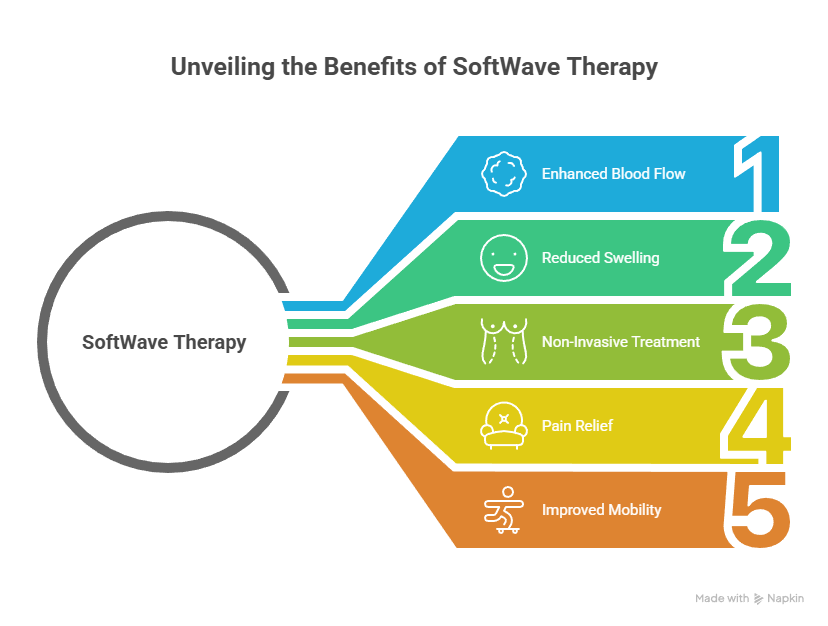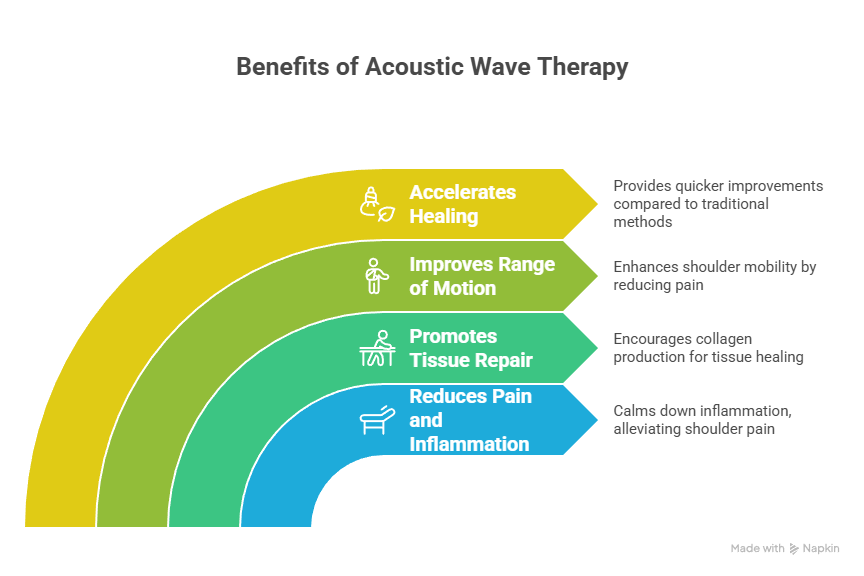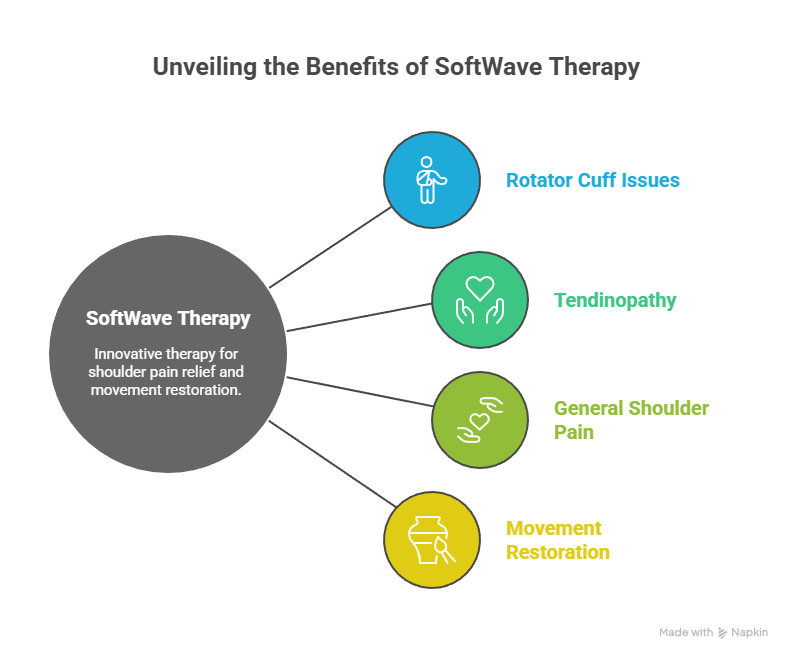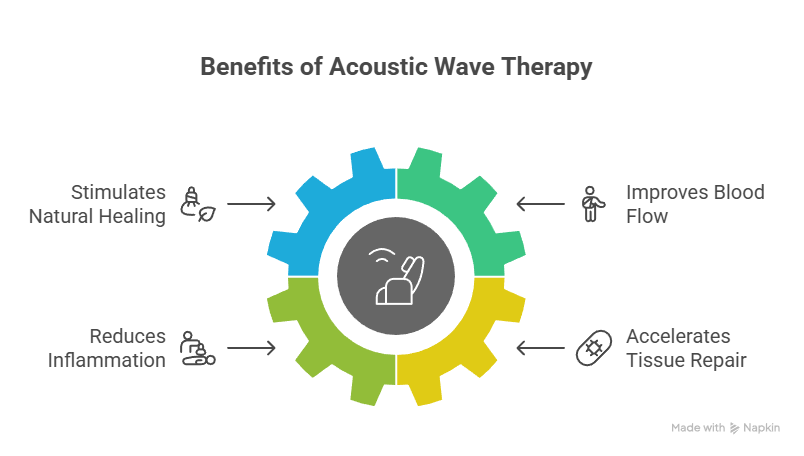Shoulder pain can really throw a wrench into your day-to-day life, making simple tasks feel impossible. Whether it’s from an old injury, overuse, or just general stiffness, finding relief is key. Many people turn to surgery or medications, but there’s a newer, non-invasive option gaining traction: SoftWave therapy. This article looks at how softwave therapy for shoulder pain works to help you move better and feel better, without all the usual fuss.

Key Takeaways
- SoftWave therapy uses sound waves to encourage your body’s natural healing. It helps with blood flow and reduces swelling, which can speed up recovery for shoulder issues.
- This treatment is good for different shoulder problems, like rotator cuff injuries and frozen shoulder, and it’s a way to get better without surgery or strong medicines.
- People often feel less pain and move their shoulders more easily after just a few SoftWave sessions, with no need for long recovery times.
Understanding SoftWave Therapy for Shoulder Pain and How It Improves Mobility
Shoulder pain can really put a damper on your day-to-day life, making simple tasks feel like a huge challenge. Whether it’s from an old injury, overuse, or just the wear and tear of time, finding relief is key. This is where SoftWave therapy for shoulder mobility comes into play. It’s a treatment that uses acoustic waves to encourage your body’s natural healing processes.

Think of it like this: the therapy sends gentle energy waves into the injured area. These waves help to increase blood flow and stimulate cells to repair themselves. This non-invasive approach aims to address the root cause of the pain, not just mask the symptoms. It’s a way to help tissues like muscles, tendons, and ligaments heal more effectively.
Here’s a look at what SoftWave therapy can do for shoulder issues:
- Reduces Pain and Inflammation: The acoustic waves can calm down inflammation, which is often a big part of shoulder pain.
- Promotes Tissue Repair: It encourages your body to produce more collagen and other building blocks needed for healing damaged tissues.
- Improves Range of Motion: By reducing pain and helping tissues recover, you’ll likely find it easier to move your shoulder, leading to better mobility.
- Accelerates Healing: Many patients notice improvements relatively quickly, sometimes within just a few sessions, compared to traditional methods that can take much longer.
SoftWave therapy is a modern option for shoulder pain that works with your body’s own healing power. It’s designed to be comfortable and effective, helping you get back to doing the things you enjoy without the constant ache.
It’s not about surgery or strong medications; the goal is to support your body so it can repair and restore itself naturally. This can lead to lasting relief and a significant improvement in how well you can use your shoulder.
The Science Behind SoftWave Therapy for Shoulder Pain Relief
So, how does SoftWave shoulder pain treatment actually work? It’s not magic, it’s science. The therapy uses acoustic waves, kind of like sound waves but more powerful, to get deep into your shoulder tissues. These waves are different from what you might find in other devices; they have a strong positive pressure and a quick rise time, which helps them do their job effectively.
The main goal is to get your body to start healing itself. When the SoftWave energy reaches the injured or painful area, it triggers a few key biological responses. First, it helps increase blood flow to the region. More blood means more oxygen and nutrients get to the damaged cells, which is pretty important for repair. It also encourages the release of your body’s own natural growth factors and even activates stem cells. Think of stem cells as the body’s repair crew – they can turn into different types of cells needed to fix damaged tissue.
Here’s a quick rundown of what happens:
- Stimulates Cell Regeneration: The acoustic waves encourage cells to repair and regenerate, which is key for healing things like torn tendons or strained muscles.
- Reduces Inflammation: SoftWave therapy can help calm down inflammation, which is often a big part of why your shoulder hurts and feels stiff.
- Pain Modulation: It actually helps your body produce natural pain relievers, like endorphins, which can make a big difference in how much pain you feel.
- Improves Blood Flow: As mentioned, better circulation brings the resources your body needs to heal.

This approach is what makes Non-surgical shoulder pain relief SoftWave therapy so effective. It’s not just masking the pain; it’s working on the underlying issues to help the tissue actually get better.
The technology behind SoftWave is designed to be broad and deep, covering a larger treatment area compared to some other shockwave therapies. This means it can reach more of the affected tissue in one go, potentially leading to better results with fewer sessions. It’s a gentler way to get powerful healing signals to where they’re needed most.
Because it works with your body’s natural processes, it’s a good option for many people who haven’t found relief with other methods. It’s about giving your shoulder the best possible environment to heal itself.
SoftWave Therapy for Shoulder Pain: Effective Recovery Without Surgery
Dealing with shoulder pain can really put a damper on things, making everyday tasks feel like a chore. Many people find themselves looking for solutions that don’t involve going under the knife or relying on long-term medication. This is where SoftWave therapy shoulder recovery comes into play as a promising alternative. It’s a non-invasive approach that aims to help your body heal itself.
SoftWave therapy offers a way to address shoulder issues without the need for surgery. Instead of invasive procedures, it uses acoustic waves to encourage your body’s natural healing processes. This means no incisions, no anesthesia, and importantly, no lengthy downtime. You can often get back to your regular activities pretty much right away, which is a huge plus for anyone trying to manage pain while keeping up with life.
Here’s a look at what makes it stand out:
- Non-Invasive Treatment: It bypasses the risks and recovery periods associated with surgical interventions.
- Accelerated Healing: The therapy works to improve blood flow and stimulate tissue regeneration, helping injuries mend faster.
- Pain and Inflammation Reduction: It targets pain at its source by reducing inflammation in the affected tissues.
- Stem Cell Activation: The treatment can encourage the body’s own stem cells to aid in the repair process.

Many patients turn to SoftWave therapy when other methods haven’t provided the relief they need. It’s been shown to help with various shoulder conditions, including rotator cuff issues, tendinopathy, and general shoulder pain. The goal is to help you regain movement and reduce discomfort, allowing you to get back to the activities you enjoy. You can find out more about this innovative treatment by visiting SoftWave therapy.
The process itself is quite straightforward. A therapist uses a device to deliver unfocused shock waves to the painful area. These waves penetrate deep into the tissues, signaling your body to start its repair work. Most people find the sessions to be comfortable, with minimal to no pain during the treatment.
While the therapy is designed to be gentle, some minor, temporary reactions like slight redness or tenderness in the treated area might occur. These usually resolve within a day or two. Following your provider’s advice, like engaging in light activity, can help support the healing process. It’s about getting you back to feeling like yourself again, without the complications of surgery.
How SoftWave Therapy for Shoulder Pain Helps Rotator Cuff Injuries Heal Faster
Rotator cuff injuries can be a real pain, literally. They happen when the tendons or muscles around your shoulder get strained or torn, often from doing the same motions over and over or from a sudden injury. This can make simple things like reaching for a cup or even sleeping on your side really difficult. Traditional treatments sometimes involve surgery or long recovery periods, which isn’t ideal for everyone.

This is where SoftWave therapy for rotator cuff injury comes into play. It’s a non-invasive approach that uses acoustic waves to get deep into the injured tissue. Think of it like a gentle nudge that tells your body, “Hey, time to heal here!” These waves help increase blood flow to the area, which is super important for bringing in the nutrients and oxygen your tissues need to repair themselves. It also seems to kickstart the body’s natural repair processes, including activating stem cells.
What’s really neat is how it helps speed things up. Instead of just masking the pain, SoftWave therapy aims to fix the underlying issue. For rotator cuff tears or tendinitis, this means helping those damaged tendons rebuild and become stronger. Many patients notice a difference pretty quickly, often within a few sessions. It’s a way to get back to your normal activities without the long wait that often comes with more invasive options.
Here’s a quick look at what happens:
- Stimulates natural healing: The acoustic waves encourage your body’s own repair mechanisms.
- Improves blood flow: More blood means more healing resources get to the injured spot.
- Reduces inflammation: This helps calm down the pain and allows healing to begin.
- Accelerates tissue repair: Damaged tendons and muscles can mend faster.
The goal with SoftWave therapy is to help your body heal itself more efficiently, reducing pain and restoring function to your shoulder so you can get back to doing the things you enjoy without constant discomfort.
It’s a promising option for those dealing with the frustration of a rotator cuff injury, offering a path to recovery that’s often quicker and less disruptive than surgery. If you’re struggling with shoulder pain, exploring treatments like SoftWave for knee pain might be a good step to consider for your overall joint health.
Real Results: What Patients Experience After SoftWave Therapy for Shoulder Pain
It’s always good to hear from people who’ve actually gone through a treatment, right? When it comes to SoftWave Therapy for shoulder pain, the feedback is pretty consistent. Many patients report feeling a noticeable difference, often quite quickly. Some even say they feel almost back to normal after just one session.
Think about Dr. Evan, who dealt with shoulder pain for over a decade after a football injury. He found relief after his first SoftWave treatment, noting less pain when swinging his arm. Then there’s Renardo, who couldn’t lift his shoulders fully before treatment. After one session, he felt like his shoulders were back to how they should be. Dr. Heather, a chiropractor herself, also experienced significant relief after her first treatment, saying her shoulder felt a “ton better.”
These aren’t just isolated stories. Studies show that SoftWave Therapy can lead to significant improvements in pain complaints. For instance, one study on calcifying tendinitis of the shoulder found that extracorporeal shockwave therapy (ESWT) led to good or excellent outcomes in nearly 88% of cases, with many seeing calcium deposits reduce and shoulder function improve. This kind of result is why many patients find SoftWave Therapy to be the breakthrough they needed, especially when other methods like injections or physical therapy didn’t quite cut it.

Here’s a general idea of what people often experience:
- Significant pain reduction, often felt within the first few sessions.
- Improved mobility and function in the shoulder joint.
- Faster recovery compared to traditional timelines for certain injuries.
- A renewed ability to get back to activities they had to give up.
It’s important to remember that everyone’s body responds a bit differently. The exact results can depend on the specific injury, how long it’s been there, and your overall health. But the general trend is positive, with many patients expressing high satisfaction and recommending the therapy to others. It’s a non-invasive way to help your body heal itself.
Most patients can go back to their regular daily activities right after a session. There’s usually no downtime, which is a big plus. Some might feel a little tenderness or see slight redness in the treated area, but this typically fades within a day or two. It’s a straightforward process that helps you get back to living without constant shoulder discomfort. If you’re looking for a way to address persistent shoulder issues, exploring options like SoftWave’s broad acoustic waves could be a good next step.
Curious about what people actually feel after getting SoftWave Therapy for shoulder pain? Our section, “Real Results: What Patients Experience After SoftWave Therapy for Shoulder Pain,” shares their stories. Many patients report feeling much better and getting back to their daily lives without the constant ache. Ready to see if this could be your path to relief? Visit our website to learn more and book your appointment today!
Moving Forward with SoftWave Therapy
So, if you’re dealing with shoulder pain that just won’t quit, or if your shoulder just isn’t moving like it used to, SoftWave Therapy seems like a really solid option to look into. It’s not surgery, it’s not a bunch of pills, and people seem to get back to their normal lives pretty quickly afterward. It works by getting your body to heal itself, which is pretty neat. Lots of folks have found relief with it, especially when other things didn’t quite do the trick. It’s definitely something to consider if you want to get your shoulder feeling better and moving freely again without a lot of fuss.
Frequently Asked Questions

What exactly is SoftWave Therapy and how does it help shoulder pain?
SoftWave Therapy uses special sound waves, like gentle pulses, to help your body heal itself. For shoulder pain, these waves can encourage more blood to flow to the area, which helps reduce swelling and speeds up the repair of damaged tissues. It’s a way to help your shoulder feel better and move more freely without surgery.
Is SoftWave Therapy a painful treatment for shoulder injuries?
Most people find SoftWave Therapy to be quite comfortable. You might feel a light tapping sensation during the treatment. It’s designed to be gentle, and the goal is to help you feel better, not to cause more pain. Unlike some other treatments, it doesn’t require anesthesia or numbing agents.
How quickly can I expect to see results from SoftWave Therapy for my shoulder?
Many patients notice a difference in their shoulder pain and how well they can move it within just a few sessions. While some people feel better right away, the healing process continues over time. The exact speed of improvement can depend on the specific shoulder issue and your overall health, but the therapy works to provide lasting relief.
If you have any additional quesitons or if you would like to see if Softwave Therapy is right for you, please contact us at Waters Edge Medical Clinic 727-550-0855.

